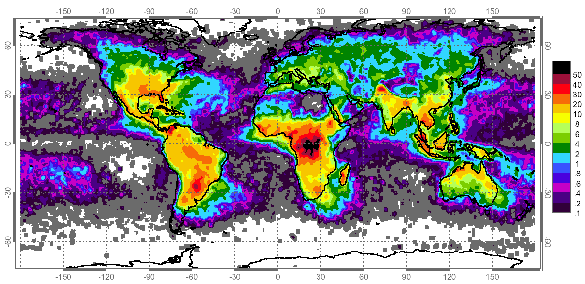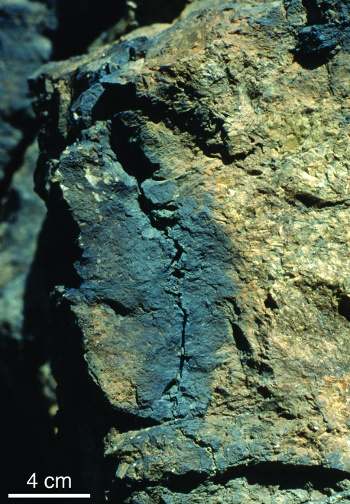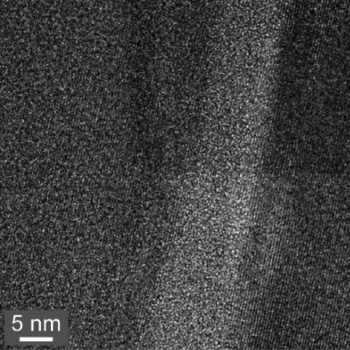Lightning Striking Again
September 17, 2015
Zeus was the
king of the
gods, and the
symbol of his power was a
thunderbolt; that is,
lightning. He obtained lightning as a gift from the
Cyclops, a
primordial race of
giants, and he was known by the
epithets, Αστραπηος (Astrapios, Lightning Wielder) and Βροντηος (Brontios, Thunderer). If one of these names sounds familiar, you're likely thinking of
Brontosaurus, the "Thunder Lizard."

Zeus in his war chariot wielding a thunderbolt.
(From "Stories from the Greek Tragedians," by Alfred Church, Dodd, Mead and Company, New York, 1879, Project Gutenberg, via Wikimedia Commons.)
Lightning is often used as a
metaphor for the power of
nature, as found in everything from
Saturday morning cartoons to
company logos and
government emblems. This reputation is well deserved, since the
electrical current in a lightning bolt is tens of thousands of
amperes. Compare this with the ten amperes of a typical
hair dryer. The
electrical power contained in a typical bolt is nearly a million
watt-hours.

An iron fist would likely make a good lightning rod.
Emblem of the (Provisional) United States Air Force Cyber Command.
(Via Wikimedia Commons.)
One interesting
cultural reference to lightning can be found in the 2002
film,
Sweet Home Alabama. A main
character creates
glass sculptures by driving
rebar into
beach sand as lightning rods. The electrical current, flowing through the
metal rod, fuses the sand into an intricate glass pattern. In the film, these
fulgurites have a more
artistic appearance than the typical lightning product.
As can be imagined, lightning causes problems for
aviation. Many air travelers, myself included, have been delayed by a rule that aircraft can't be
fueled during a
lightning storm. According to the
National Lightning Safety Institute,[2] nine
aircraft have been lost in flight from lightning strikes, all in
decades prior to the time when aircraft systems were redesigned to mitigate lightning damage. Just last month, a
Boeing 737 awaiting
takeoff at the
Atlanta airport was struck by lightning, but with no ill affects to the passengers and crew.[3]
A high-powered
laser creates a
ray that's a compact path of intense
electromagnetism, so the idea arose soon after its invention that laser beams could be used to direct the path of a lightning bolt to ground by generating a
plasma in the
air molecules.[4] The early
experiments had disappointing results, since the long
pulse lasers of that era produced discontinuous plasmas. The short pulse lasers of today have shown better results when special techniques are employed.[5-6] I wrote about laser lightning rods in an
earlier article (Laser Lightning Rod, March 23, 2012).
The
Internet has enabled many
crowd-sourced projects, one of which is a very useful
lightning monitoring network facilitated by
Blitzortung.org.[6] Lightning is detected by its
radio signature, and the time delay of the
radio frequency pulse allows a determination of the stroke location. The
radio receivers cost about $200, and the many
volunteers make this network possible. A nice
graphical view of the data can be seen at
lightningmaps.org.[7] The time evolution of lightning over the course of 2014 can be seen in a
YouTube video.[8]

Lightning strike probability map of the world created from space-based optical sensors. The units are flashes per square kilometer per year. Click for larger image. (NSSTC Lightning Team image, via NASA.)[9)]
An international team of
scientists from the
University of Pennsylvania (Philadelphia, Pennsylvania), the
Albert-Ludwigs-Universität (Freiburg, Germany), the
GeoForschungsZentrum Potsdam (Potsdam, Germany), and the
Australian Nuclear Science and Technology Organization (ANSTO, New South Wales, Australia), has found that a black patch of
rock with an unusual structure in a
granite outcrop in
southern France is a fulgurite formed by a powerful bolt of lightning.[10-11]
The study, published in the
journal,
American Mineralogist, was led by
Reto Gieré,
chair of the University of Pennsylvania
Department of Earth & Environmental Science, with collaborators
Wolfhard Wimmenauer and
Hiltrud Müller-Sigmund of the Albert-Ludwigs-Universität,
Richard Wirth of GeoForschungsZentrum Potsdam, and
Gregory R. Lumpkin and Katherine L. Smith of the Australian Nuclear Science and Technology Organization.[10-11]
The rock outcropping, located near
Les Pradals in southern France, has a jagged fracture in granite that's discolored black.[11] The black layer, which is the lightning-formed fulgurite, appears under an
optical microscope as a
porous, shiny
ceramic glaze.[11]
Chemical analysis of the fulgurite layer showed elevated levels of
phosphorous pentoxide and
sulfur dioxide that may have come from
lichen living at the rock's surface when lightning struck.[11]

The granite fulgurite found near Les Pradals, France.
(University of Pennsylvania image.)
Transmission electron microscopy
showed that the fulgurite was
amorphous, having formed from highly heated
material that was cooled quickly.[11] However, the region adjacent to the fulgurite contained
shock lamellae; that is, material appearing as straight,
parallel lines. Such a feature occurs when
quartz or other
minerals are deformed by a large
pressure wave.[11] Says Gieré,
"It's like if someone pushes you, you rearrange your body to be comfortable... The mineral does the same thing."[11]
The layer of lamellae was only about three
micrometers thick. Before this study, the only known
natural events producing lamellae were
meteor impacts.[11] Meteor impacts form these lamellae form at
pressures in the range of 10
gigapascals.[11] The fulgurite-producing lightning strike must have generated a pressure pulse in that range.[10]

A transmission electron micrograph of the parallel lines of the shock lamellae.
(University of Pennsylvania image.)
This study shows that not all shock lamellae are indicative of a meteor strike.[11] Says Gieré,
"...This is a good reminder to always use multiple observations to draw big conclusions, that there are multiple mechanisms that can result in a similar effect."[11]
Rock climbers and
hikers are advised that when they see a shiny black glaze on a rock, it indicates a site where lightning has struck before, and it might strike again.[11]
References:
- Sweet Home Alabama (2002, Andy Tennant, Director) on the Internet Movie Database.
- Aviation Losses from Lightning Strikes, National Lightning Safety Institute.
- Lightning strikes Boeing 737 plane preparing for take-off, Telegraph (UK), August 20, 2015; Lightning strikes Delta's Boeing 737 plane at Atlanta airport, YouTube Video by videolandmarks, Aug 20, 2015.
- Arnold A. Barnes, Jr. and Robert O. Berthel, "A Survey of Laser Lightning Rod Techniques," Proceedings of the Cocoa Beach onference (Cocoa Beach, Florida, April 16-19, 1991), pp. 53-1 thru 53-6.
- Maik Scheller, Matthew S. Mills, Mohammad-Ali Miri, Weibo Cheng, Jerome V. Moloney, Miroslav Kolesik, Pavel Polynkin, and Demetrios N. Christodoulides, "Externally refuelled optical filaments," Nature Photonics, vol. 8, no. 4 (March 23, 2014), pp. 297-301, doi:10.1038/nphoton.2014.47.
- B. Forestier, A. Houard, I. Revel, M. Durand, Y. B. André, B. Prade, A. Jarnac, J. Carbonnel, M. Le Nevé, J. C. de Miscault, B. Esmiller, D. Chapuis and A. Mysyrowicz, "Triggering, guiding and deviation of long air spark discharges with femtosecond laser filament," AIP Advances, vol. 2, no. 1 (March, 2012), Document No. 1.3690961 (13 pages).
- Real-Time Lightning Map, lightningmaps.org from Blitzortung.org data.
- Year 2014 of Lightning by Vaisala Global Lightning Dataset GLD360, YouTube Video by the VaisalaGroup, January 25, 2015.
- Where LightningStrikes, NASA, December 5, 2001.
- Reto Gieré, Wolfhard Wimmenauer, Hiltrud Müller-Sigmund, Richard Wirth, Gregory R. Lumpkin, and Katherine L. Smith, "Lightning-induced shock lamellae in quartz," American Mineralogist, vol. 100, no. 7 (July, 2015), pp. 1645-1648, doi: 10.2138/am-2015-5218.
- Lightning Reshapes Rocks at the Atomic Level, Penn Study Finds, University of Pennsylvania Press Release, August 5, 2015.
Permanent Link to this article
Linked Keywords: Zeus; king; god; symbol; thunderbolt; lightning; Cyclops; Greek primordial deities; giant - mythology; epithet; Brontosaurus; war chariot; Project Gutenberg; Wikimedia Commons; metaphor; nature; Saturday morning cartoon; company logo; government; emblem; electrical current; ampere; hair dryer; electrical power; watt-hour; iron; fist; lightning rod; (Provisional) United States Air Force Cyber Command; cultural reference; Sweet Home Alabama; character; studio glass; glass sculpture; rebar; beach; sand; metal; fulgurite; art; artistic; aviation; aviation fuel; thunderstorm; lightning storm; National Lightning Safety Institute; aircraft; decade; Boeing 737; takeoff; Hartsfield Jackson Atlanta International Airport; laser; ray; electromagnetism; plasma; air; molecule; experiment; pulse; Internet; crowdsourcing; crowd-sourced; lightning detection; lightning monitoring; Blitzortung.org; radio frequency; spectrogram; signature; radio receiver; volunteer; information graphic; lightningmaps.org; YouTube; video; lightning strike; probability; world map; Earth observation satellite; space-based; optical; sensor; square kilometer; scientist; University of Pennsylvania (Philadelphia, Pennsylvania); Albert-Ludwigs-Universität (Freiburg, Germany); GeoForschungsZentrum Potsdam (Potsdam, Germany); Australian Nuclear Science and Technology Organization; rock; granite; outcrop; southern France; scientific journal; American Mineralogist; Reto Gieré; chairman; chair; Department of Earth & Environmental Science; Wolfhard Wimmenauer; Hiltrud Müller-Sigmund; Richard Wirth; Gregory R. Lumpkin; optical microscope; porosity; porous; ceramic glaze; analytical chemistry; chemical analysis; phosphorous pentoxide; sulfur dioxide; lichen; granite; fulgurite; Les Pradals, France; transmission electron microscopy; amorphous; material; shock; lamella; parallel lines; quartz; mineral; shock wave; pressure wave; micrometer; nature; natural; impact event; meteor impact; pressure; gigapascal; transmission electron micrograph; rock climbing; rock climber; hiking; hiker.